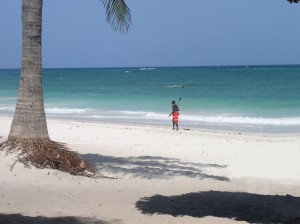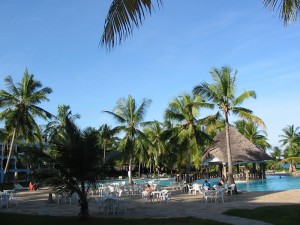Mombasa Travel Guide
Mombasa travel appeals to all interests and all sizes of pocketbooks. History buffs are thrilled by the intact ramparts and walls of the 16th century Fort Jesus and the narrow streets of Old Town, water sports junkies get to dive in some of the world’s best dive sites and adventure seekers are thrilled to watch wildlife at play at the famed Kenyan game parks.
mombasa beach

Mombasa - White Sandy Beaches
Mombasa is an island, connected to the mainland by causeways, bridges and ferry. As you approach from the ocean, one of the most remarkable sights is the imposing Fort Jesus which was built to guard the harbor entrance and solidify the presence of the Portuguese along the Kenyan Coast.
In a spectacular sound and light show held on certain nights of the week, visitors are ushered to their seats by the light of flaming torches and actors recreate the battles carried out around the Fort. A dinner by starlight in the old courtyard finishes a memorable evening.
The city is principally a port but to its north and south are wide stretches of sun-drenched white sandy beaches and a wide variety of hotel resorts ranging from sumptuously luxurious to basic no-frills.
Mombasa has become important as a safari hub and many tourists come to the beach before or after a safari to relax. However, enticed by fabulous water sports, spectacular marine parks and sunsets on an authentic Arab dhow, it is likely they do not chill for very long.

Mombasa Hotels
Although the top end beach resorts offer every luxury from champagne breakfasts to pampering spas, those who want privacy opt for self-catering cottages found along the coast. These range from fairly basic lodgings to high-styled thatched cottages which come equipped with house staff, tennis courts and swimming pools. There is something for everyone in Mombasa.
Up and down the coast is a string of islands on which are ruins of mosques, tombs and forts. Once home to several thousands, Gedi, which lies two hours north of Mombasa, almost overnight become a lost city.
Further north, the sand dunes in Lamu conceal long deserted settlements thought to be more than a thousand years old. Lamu’s medieval stone town, much visited by archaeological buffs, is one of the last few intact remnants of the Swahili civilization which was the dominant force until the British arrived.
Along with the beaches, the game parks are the most visited attractions in Mombasa. Visit the elephant sanctuary in nearby Shimba Hills Reserve or go further afield to one of six national parks which cover more than 24,000 sq kilometers in total.
In renowned Maasai Mara, one of the most breath-taking sights is the annual migration of up to one and a half million wildebeest. This is most spectacular in August. Otherwise, there are giraffe, zebra, gazelle, elephant, eland, ostrich, buffalo, ostrich, kongoni, topi and lions, lots of them, to look out for.
Adventure awaits you in Mombasa. The dry season, from July to October, is the best time to visit as the temperatures are milder and the air is not so humid. Peak Mombasa travel period takes place from December to March, which are also the months when the water is clearest for diving, snorkeling, and deep-sea fishing.


 KES 14,350 PPS
KES 14,350 PPS

 KES 12,600 PPS
KES 12,600 PPS 



